 - Exam Center
- Ticket Center
- Flash Cards
- Electric Circuits
Ohm's Law Practice Problems With Solutions for High SchoolExcel in solving any Ohm’s law problems with this comprehensive guide. It’s your ultimate toolkit for tackling homework and acing the AP Physics exam. If you are a teacher looking for a resource to assess your students, download this Ohm’s law worksheet . Ohm's Law Practice Problems:Problem (1): An electronic device has a resistance of 20 ohms, and a current of 15 A passes through it. What is the voltage across the device? Solution : Resistance, current, and voltage are related together by Ohm's law as $V=IR$. Thus, the voltage of the device is given by \begin{align*}V&=IR\\&=15\times 20\\&=300\quad {\rm V}\end{align*} Problem (2): A $3-{\rm V}$ potential difference is applied across a $6\,{\rm \Omega}$ resistor. What is the current that flows into the resistor? Solution : Ohm's law states the potential difference across a resistor is resistance times current, so we get \begin{align*} I&=\frac VR\\&=\frac {3}{6}\\&=0.5\quad {\rm A}\end{align*} Problem (3): An electric device is connected to a $120-\rm V$ outlet and draws $6\,\rm A$ of current. How much heat will this device produce in $3$ minutes? Solution : To solve this simple question, we must combine three fundamental equations as follows: \begin{gather*} \text{Ohm's law}: \, I=\frac{V}{R}\\\\ \text{Power}: P=\frac{E}{t} \\\\ \text{Electric power}: P=V\times I \end{gather*} where $E$ is energy. Recall from heat problems that heat is energy. Combining these equations yields \begin{align*} E&=Pt \\\\ &=VIt\\\\ &=(120)(6)(3\times 60\,\rm s) \\\\ &=129600\,\rm J\end{align*} or in scientific notation as \[E=1.29\times 10^5\,\rm J\] Problem (4): In the circuit shown below, how much current does the ammeter show? 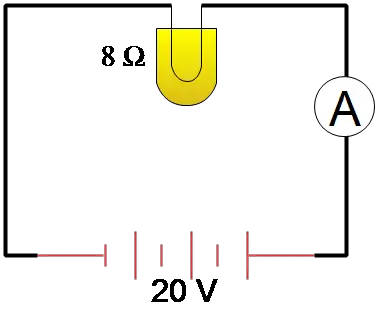 Problem (5): In a circuit, a $10\,{\rm \Omega}$ resistor is removed and replaced by a $20\,{\rm \Omega}$ resistor. What happens to the current in the circuit? Solution : Since nothing is said about the voltage drop across the circuit, we assume it is constant, say $V=120\,{\rm V}$. Therefore, using Ohm's law formula, $I=\frac VR$, current $I=\frac{120}{10}=12\,{\rm A}$ flows through the $10\,{\rm \Omega}$ resistor, and $I=\frac{120}{20}=6\,{\rm A}$ through the $20\,{\rm \Omega}$ resistor. We can see that for the same voltage, doubling the resistances results in decreasing, or more precisely, halving, the currents. This is a clear demonstration of Ohm’s law. Question: A circuit consists of a battery and a resistor. The resistor dissipates $2\,\rm W$. Now the resistor is replaced with one that has twice the resistance of the original. What power does the new resistor dissipate? Solution : The power dissipated (or consumed) by a resistor is determined by one of the following formulas: \[P=V\times I=\frac{V^2}{R}=RI^2\] where $V$ is the potential drop across the resistor. Ohm's law tells us that the current through a resistor is inversely proportional to its resistance, i.e., $I\propto \frac 1R$. In this problem, the new resistor has twice the resistance of the original resistor, i.e., $R'=2R$ whereas it is connected across the same battery, $V'=V$. Thus, the current flowing through this new resistor is related to the old one as below: \begin{align*} \frac{i'}{i}&=\frac{R}{R'} \\\\ &=\frac{R}{2R} \\\\ \Rightarrow i'&=\frac 12 i\end{align*} Given the current in the replaced resistor, substitute it into one of the above power formulas, say $P'=V'i'$. \begin{align*} P'&=V'i' \\\\ &=V(\frac 12 i) \\\\ &=\frac 12 \underbrace{Vi}_{P} \\\\ &=\frac 12 \times 2 \\\\ \Rightarrow \quad P'&=\boxed{1\,\rm W} \end{align*} Therefore, the new resistor would dissipate $1\,\rm W$ of electric power. Question: A hair dryer is plugged into a $240\,\rm V$ outlet and draws a current of $3.6\,\rm A$. (a) If the voltage drops by $25\%$ and nothing else changes, how much will the current be? (b) Assuming that the resistance of the device was reduced by $25\%$, what current would be drawn at $240\,\rm V$? Solution : This type of Ohm's law question typically appears in AP Physics classes. (a) We are told that the voltage is reduced by $25\%$ of the original voltage, meaning that \[V_2=V_1-(0.25)V_1=0.75V_1\] In addition, it is assumed that the resistance of the device has not changed, i.e., $R_2=R_1$. Applying Ohm's law formula on both sides of this relation and solving for the unknown current $I_2$ gives us \begin{align*} R_2&=R_1 \\\\ \frac{V_2}{I_2}&=\frac{V_1}{I_1} \\\\ \Rightarrow I_2&=I_1\left(\frac{V_2}{V_1}\right) \\\\ &=(3.6)\left(\frac{0.75V_1}{V_1}\right) \\\\ &=\boxed{2.7\,\rm A} \end{align*} With a $25\%$ reduction in the original voltage, the current drawn by the device is also reduced by as much as $2.7\,\rm A$. (b) Now, the resistance varies and reduces by $25\%$ of the original resistance, i.e., \[R_2=R_1-0.25R_1=0.75 R_1\] The voltage across the device is held constant, i.e., $V_2=V_1$. As above, applying Ohm's law formula gives us \begin{align*} V_2&=V_1 \\\\ I_2R_2&=I_1 R_1 \\\\ \Rightarrow I_2&=I_1 \left(\frac{R_1}{R_2}\right) \\\\&=(3.6)\left(\frac{R_1}{0.75R_1}\right) \\\\ &=\boxed{4.8\,\rm A} \end{align*} The current will be $4.8\,\rm A$ if the resistance is reduced by $25\%$ at $240\,\rm V$. Ohm's Law: Conceptual QuestionsHere are some simple conceptual questions about Ohm's Law. Question: When you double the voltage across a conducting wire, you observe that the current increases by a factor of $4$. What can you conclude about this experiment? Solution : The resistance of a conducting wire is defined as the ratio of the voltage drop across it to the current that passes through it, $R=\frac{\Delta V}{I}$. This relationship is commonly referred to as Ohm's law. For ohmic materials, the resistance, $R$, is always constant and does not change, either by changing voltage or current. In this question, the voltage was doubled $V'=2V$ and it was observed that the current was quadrupled $I'=4I$. Applying Ohm's law gives \begin{align*} R' &=\frac{V'}{I'} \\\\ &=\frac{2V}{4I} \\\\ &=\left(\frac 12\right) \frac VI \\\\ \Rightarrow R' &=\frac 12 R \end{align*} As you can see, the new resistance is halved, which contradicts the assumption that for an ohmic material, the $R$ value should be constant. Therefore, we conclude that this conducting wire does not obey Ohm's law. This is a clear demonstration of the limitations of Ohm’s law and its applicability to real-world materials. It’s important to remember that Ohm’s law is an idealized model and may not hold true under all circumstances. Question: All lamps are identical in the circuit shown. If the switch is closed, what happens to the brightness of bulb A?  Solution : In a parallel circuit, each lamp has its own independent circuit to the battery. Therefore, if one lamp fails (i.e., its filament breaks) or is added to the circuit by an on/off switch, it will not affect the other lamp. The brightness of the remaining lamp will stay the same because the same amount of current will continue to flow through it. This is one of the advantages of parallel circuits in practical applications like home lighting. Even if one light goes out, the others will continue to shine brightly. Question: In the circuit illustrated, rank each branch of the circuits, from greatest to least, according to (a) The voltage drop across each (b) The current through each 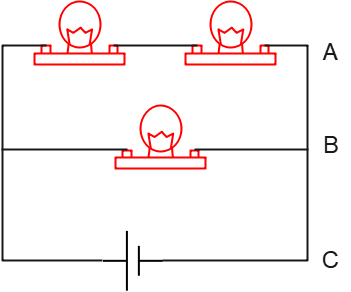 Solution: We want to solve this question without any mathematical calculation. (a) All three branches are in parallel with each other, so the potential drop of each is the same and equal to the voltage of the battery. \[V_C=V_A=V_B\] (b) Assuming an ideal battery (without internal resistance), the top branch has two resistors, the middle branch has one, and the third branch has none. The top branch is therefore more resistant than the other branches. On the other hand, they are all the same voltage. Ohm's law states that any branch with more resistance draws less current as a result. As a result, we have \[I_C>I_B>I_A\] Question: In the circuit illustrated, compare the brightness of each identical bulb. (a) Which bulbs draw the most current? (b) What will happen if lamp $A$ is burned out? or if lamp $C$ is unscrewed?  Solution : The light bulb's brightness intensity is determined by the wattage using (power) of that bulb. The power, also, is found using one of the following formulas \[P=VI=\frac{V^2}{R}=RI^2\] The more power the bulb dissipates, the brighter it shines. The terminals of bulb C are connected directly to the battery, so the voltage across bulb C is the same as that of the battery. The three bulbs are identical, so the equivalent resistance This circuit is made up of two parallel branches. There is more resistance in the upper branch of the circuit, so according to Ohm's law $I=\frac VR$, less current passes through this branch than in the lower branch, including one resistor (bulb). \[i_{AB}<i_C\] Therefore, bulb C is the brightest because it draws more current than the top bulbs. (b) Both bulbs $A$ and $B$ are connected in series and share the same current. Failing a bulb connected in series to others, say $A$, stops flowing the current through that branch. Thus, both top bulbs no longer give light and are turned off. The lamp $C$ is connected in parallel with the other two bulbs and unscrewing it does not affect the others on the top branch, because it is connected directly to the terminals of the battery. Therefore, It glows as before. Question: We have two identical light bulbs and a battery. (a) Will they shine brighter if they are connected in series or in parallel? (b) In which case does the battery drain faster? Solution : Either the amount of current that flows through a lightbulb or the amount of power that it dissipates determines how bright it is. (a) When two bulbs are connected in series to an ideal battery, they share a common current determined by the following Ohm's law formula: \[I_1=I_2=\frac{V}{R_1+R_2}\] Setting $R_1=R_2=R$ gets \[I_1=I_2=\frac{V}{2R}\] In the case of a parallel combination of two resistors, the equivalent resistance is given by the following well-known formula: \[R_{eq}=\frac{R_1 R_2}{R_1+R_2}\] On the other hand, Ohm's law formula, $I=\frac{V}{R}$, gives us the current that passes through the battery. \begin{align*} I_{tot}&=\frac{V}{R_{eq}} \\\\ &=(R_1+R_2)\,\frac{V}{R_1 R_2}\end{align*} Again, for two identical bulbs (or resistors), we have \[I_{tot}=2\times \frac{V}{R}\] This is the current through each parallel branch. As a result, you can see that, if the bulbs are identical, the current in the parallel case is four times that in the series combination. (b) The amount of power dissipation by a battery determines how quickly it drains, which is given by the following power formula \[P_{diss}=VI_{tot}\] where $V$ is the voltage across the battery. As you can see above, connecting two identical bulbs in parallel will draw more current from the battery than connecting them in series. Consequently, the more current is drawn from the battery, the more power is dissipated by it. \begin{gather*} I_{parallel} > I_{series} \\\\ P_{parallel} > P_{series} \end{gather*} Question: In the following circuits shown, all bulbs are identical. In each circuit, a voltmeter is connected across a single bulb to measure the voltage difference across it. Rank the voltage readings from greatest to least. 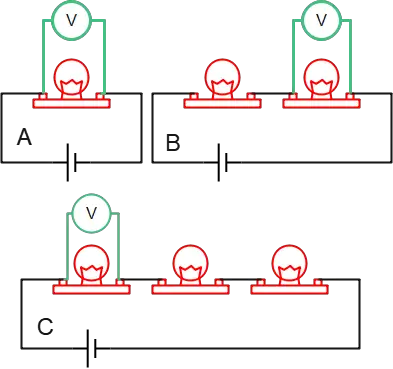 Solution : The voltage drop across each bulb is found using Ohm's law: $\Delta V=I\times R$. Assume that every lightbulb has a resistance of $R$. The only thing left to do is determine the current flowing through each bulb. Keep in mind that in each circuit, the voltmeter is connected in parallel to the lightbulb. For circuit (A), the voltage drop across the only bulb of the circuit is simply determined as \[\Delta V=\Delta V_A=I_A\times R\] where $I_A$ is the current through the bulb, which in this case, is also the same current as in the battery. $\Delta V$ is also the voltage difference across the battery. In the case of B, the two identical bulbs are connected in series. Therefore, according to the rules of series combination, the same current flows through each bulb, and the voltage drop in each bulb adds up to the voltage of the battery. The equivalent resistance of this combination is $R_{eq}=R+R=2R$, and the total current through the battery (which is the same current as each bulb) is \begin{align*} I&=\frac{\Delta V}{2R} \\\\ &=\frac 12 \frac{\Delta V}{R} \\\\ &=\frac 12 I_A\end{align*} Hence, the voltage drop across the bulb shown is \[\Delta V_B=I_B\times R = \boxed{\frac 12 I_A \times R}\] In the third circuit, only another identical bulb is added to the circuit. Thus, all calculations are similar to the second circuit, but with only a slight change. \begin{gather*} R_{eq}=R+R+R=3R \\\\ I=\frac{\Delta V}{R_{eq}}=\frac{\Delta V}{3R}=\frac 13 I_A \\\\ \Delta V_C=I_C \times R \\\\ \Delta V_C=\frac 13 I_A R \\\\ \Rightarrow \boxed{\Delta V_C=\frac 13 \Delta V_A} \end{gather*} Consequently, the rank of the voltage drop across each bulb from greatest to least is as follows \[\Delta V_A>\Delta V_B > \Delta V_C\] Question: If the voltage across a circuit increases by five times, then what would the current through the circuit be? Solution : Assuming the circuit is made of a material that obeys Ohm's law, a change in voltage will change the current so that the ratio of $\frac{\Delta V}{I}$ becomes constant. Therefore, the current also increases five times to maintain the resistance of the circuit unchanged. Question: In a certain electric circuit including a cell, connecting wires, and a filament lightbulb, which of the following would cause the lightbulb to shine less brightly? (a) Decrease or increase the resistance of the circuit. (b) Increase or decrease the voltage of the battery. Solution : As long as the current through the filament lightbulb is small, we can assume Ohm's law will be obeyed. (a) If a lightbulb shines less brightly, it means less current is passing through the filament (resistance). According to Ohm's law, the current is inversely proportional to the resistance. Therefore, an increase in the resistance will cause a decrease in the current through the filament, resulting in a dimmer lightbulb. (b) The current through the filament is related to the voltage across it by $I=\frac{\Delta V}{R}$. Assuming the resistance of the lightbulb remains constant, the current is proportional to the voltage drop. Thus, an increase in voltage causes an increase in the current through the resistor, making the lightbulb shine brighter. Question: A $12-\rm V$ battery is connected across a lightbulb with variable resistance. As the resistance increases, what happens to each of the following quantities? (a) The current through the lightbulb. (b) The voltage across the lightbulb. (c) The power consumed by the lightbulb. Solution : We have a circuit with a fixed-voltage battery of $12\,\rm V$, and a lightbulb (resistor) with variable resistance. We assume that the filament of the lightbulb is made up of a material that obeys Ohm's law. (a) According to Ohm's law, the current through a resistance is $I=\frac{\Delta V}{R}$. The voltage is assumed to be fixed, and the only alteration is due to the increases in the resistance. Thus, increasing the resistance decreases the current through the lightbulb filament. (b) The voltage across the bulb is held constant by a battery and does not change with a change in circuit resistance. (c) One of the following formulas can be used to calculate the power consumed by resistance in a circuit: \[P=I\Delta V=\frac{\Delta V^2}{R}=RI^2\] If we pick out the first formula, $P=I\Delta V$, as you can see in part (a), an increase in the resistance leads to a decrease in the current, and so does power. Ohm's Law: Homework ProblemsThe following are some homework questions appearing for Ohm's law are provided and answered. Problem (6): In the following circuits, find the unknowns. 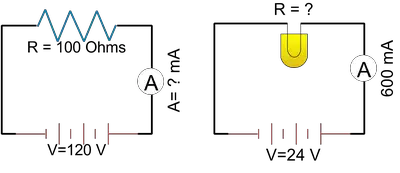 Solution : In each of the circuits, use Ohm's law $V=IR$ and solve for the unknown. In the left circuit, the current through the resistor is asked for in milliamps. Thus, \begin{align*} I&=\frac VR\\\\&=\frac{120}{100}\\\\&=1.2\quad {\rm A}\end{align*} To convert it to milliamperes, multiply it by $1000$, so we get $I=1200\,{\rm mA}$. In the right circuit, the resistance of the light bulb is unknown. As a result, \begin{align*} R&=\frac VI\\&=\frac {24}{600\times 10^{-3}} \\\\&=40\quad {\rm \Omega}\end{align*} Problem (7): In a circuit, the potential drop across the $10\,\rm k\Omega$-resistor is $100\,\rm V$. What is the current through the resistor? Solution: Substitute all known numerical values into Ohm's law equation, $V=IR$. \begin{align*} I&=\frac VR\\\\&=\frac{100\,{\rm V}}{10000\,{\rm \Omega}}\\\\&=0.01\quad {\rm A}\end{align*} Problem (8): The voltage-current curve for an ohmic conductor is plotted as shown in the figure below. What is the resistance of resistors 1 and 2? 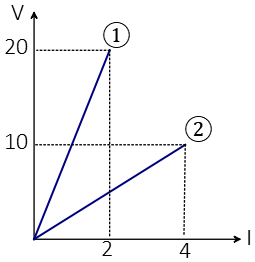 Solution : Ohm's law tells us that resistance is the slope of the voltage vs. current curve $R =\frac{\Delta V}{I}$. Recall that the slope $m$ of a straight line between two points $A(x_1,y_1)$ and $B(x_2,y_2)$ is determined as \[m=\frac{\Delta y}{\Delta x}=\frac{y_2-y_1}{x_2-x_1}\] Thus, the slope of the voltage-current curve, which is the resistance, is obtained as below: The points $A(0,0)$ and $B(2,20)$ are on the line (1):\[R_1=\frac{20-0}{2-0}=10\quad{\rm \Omega}\] The points $A(0,0)$ and $B(4,10)$ are on the line (2):\[R_2=\frac{10-0}{4-0}=2.5\quad{\rm \Omega}\] Problem (9): Reverse the position of the potential drop across a conductor and the current passing through it in the previous problem, so that the current-voltage curve is obtained. Now, find the resistance of resistors $1$ and $2$. Solution : if we rearrange Ohm's law as $I=\frac{1}{R}\Delta V$, we can see that the slope of the current-voltage curve, in this case, gives the inverse of the resistance. Therefore, as in the previous problem, the slope of the line (1) is \[\frac{1}{R_1}=\frac{20-0}{2-0}=10\] which gets the $R_1=0.1\,{\rm \Omega}$ and slope of the line (2) is \[\frac{1}{R_2}=\frac{10-0}{4-0}=2.5\] which gives $R_2=0.4\,{\rm \Omega}$. Problem (10): A student conducts an experiment and measures the current and voltage across two unknown resistors. Then she plots her findings in current-voltage coordinates, as shown in the figure. What can be said about resistors A and B?  Solution : Ohmic materials are the ones that have constant resistance over a wide range of applied voltages. In other words, in an ohmic conductor, the ratio of the voltage across it to the current through it, which is defined as resistance, is always constant. Thus, ohmic materials have a linear current-voltage relationship, and their curve passes through the origin. In contrast, materials with a resistance that changes with a potential drop or current are called non-ohmic. The curve of a non-ohmic material is not linear. Examples of non-ohmic materials that violate Ohm's law are diodes and transistors. With these explanations, as the curve of (A) is linear and passes through the origin, it is an ohmic conductor whose slope gives the reciprocal of the resistance. As in the previous problem, its resistance is calculated as $R_A=5\,{\rm \Omega}$. The resistor (B) has a nonlinear relationship between the voltage across it and the current, so it is a non-ohmic conductor with variable resistance. Problem (11): A subwoofer needs a household voltage of 110 V to push a current of 5.5 A through its coil. What is the resistance of the subwoofer? Solution : Known are the voltage difference $V=110\,{\rm V}$ and current $I=5.5\,{\rm A}$. Ohm's law relates them as below: \begin{align*} R&=\frac VI \\ \\ &=\frac{110}{5.5} \\ \\ &=20\quad {\rm \Omega}\end{align*} Problem (12): How much current is drawn from a circuit with a resistor of 1000 ohms if powered by a battery with 1.5 volts? Solution : Resistance $R=1000\,{\rm \Omega}$ and voltage $V=1.5\,{\rm V}$ are known, so we have \begin{align*}I&=\frac VR\\\\&= \frac{1.5}{1000} \\\\&= 1.5\quad {\rm mA}\end{align*} Problem (13): An electric heater has a coiled metal wire that draws a current of 100 A. The resistance of the wire is 1.1 ohms. Calculate the voltage that must be established for it. Solution : Current $I=100\,{\rm A}$ and resistance $R=1.1\,{\rm \Omega}$ are related as \begin{align*} V&=IR\\&=100\times 1.1\\&=110\quad {\rm V}\end{align*} Problem (14): The maximum current that passes through a light bulb with a resistance of 5 ohms is 10 A. How much voltage must be applied across its ends before the bulb will break? Solution : The maximum voltage can be found using Ohm's law as below: \begin{align*} V&=IR \\ &= 10\times 5\\&=50 \quad {\rm V}\end{align*} If a voltage higher than this value is applied to the circuit, the lamp will burn out. Problem (15): In a circuit, we replace the previous 1.5-volt battery with a 3-volt new one. What happens to this circuit? Solution : Ohm's law tells us that when more voltage is established across a circuit, then a higher current will flow through the resistors in that circuit, like electric heaters, light bulbs, and so on. More current can cause damage or failure to household appliances. For example, a light bulb with a resistance of $R=1.5\,{\rm \Omega}$ draws a current of $I=\frac{1.5}{1.5}=1\,{\rm A}$ with a $1.5$ volt battery and a current of $I=\frac{3}{1.5}=2\,{\rm A}$ with a replacement one. In these cases, the light bulb will most likely burn out. Ohm's law tells us that the current in a circuit is directly proportional to the voltage drop across it and inversely proportional to the circuit's resistance: \[\text{Current}=\frac{\text{voltage}}{\text{resistance}}\] or \[I=\frac{V}{R}\] Author : Dr. Ali Nemati Page Created: 12/6/2020 Last Update: May 29, 2023 © 2015 All rights reserved. by Physexams.com  Ohm’s Law Tutorial with Easy Practice ProblemsPublished Jul 01, 2020 Please accept cookies to access this content. Ohm’s Law is a foundational equation in basic circuits and is amazing in its simplicity and its usage. In this tutorial, we’re going to learn about what Ohm’s Law is, where you can and can’t use it, and do a few Ohm's law practical examples of very, very simple circuits. About Ohm’s Law EquationOhm’s Law establishes a relationship between voltage and current through a linear resistance. In the tutorial defining and relating voltage, current, resistance, and power, we used water as an example. Thinking of that analogy, it probably isn’t surprising that there is a mathematical relationship between how much water flows depending on the height of the head of water and the size of the pipe. For electricity, that relationship is established as: A few important notes: - This means that the voltage divided by the resistance gives you the current flow. Or, the height of the water divided by the size of the pipe, gives you the water flow. Intuitively, this should make sense. As you go to a higher potential, more current will want to flow. If you increase the size of the pipe by decreasing the resistance, more current will flow. And the inverse is true.
- This is a linear equation. Not only does this mean that the relationship is a straight line, but if you are dealing with something that is non-linear, where resistance changes depending on the voltage, this equation does not apply. That is uncommon so we’ll assume resistors are linear unless explicitly stated otherwise.
- This holds when you have a voltage and a resistance (usually a resistor), but as we learn about other components and power sources, this law does not typically apply to them.
- You usually get voltages from batteries, the wall outlets, and other similar places. Resistors are electronic components manufactured for specific purposes. Our Friend of CircuitBread, Ohmite , creates many passive components such as resistors. They can look very, very different, with the more typical resistors looking like Ohmite's OC Resistors , though their ARCOL series is quite famous for a higher-power option, but I've even personally seen their high-current, low resistance 280 series in elevator applications. They all look completely different but are used for their resistance.
Voltage and current can both be positive or negative. As mentioned in the previous tutorial, voltage is relative, so a negative voltage is just at a lower potential than what is (perhaps arbitrarily) established as zero volts or ground. Current, being a measurement of flow, is positive or negative depending on which way you, or the problem, assigns the flow. If you say that the current is flowing from A to B, and the current is actually flowing from B to A, then that current is negative. However, if you look at the same situation and reference the current as flowing from B to A, then when current does flow from B to A, it is a positive current flow! This can be really confusing at first and both of these still trip me up if I haven’t done any circuit problems for awhile. The most important thing to keep these straight is to draw out your assumptions of voltage potential and current flow and make sure that the equations you use match those assumptions. We’ll review this concept in some of the practice problems at the end of this tutorial. There are two common extremes that you can see in Ohm’s Law in regards to resistance. When resistance is zero and when resistance is infinite. When resistance is zero, basically when a wire is connecting two different voltage potentials, this is called a short circuit. It’s shorting the voltages together. Looking at Ohm’s Law, when resistance is zero, if you have any finite voltage, you get an infinite current. While there’s no such thing as an infinite current in real life, if this isn’t planned, the current will be high enough to cause some damage! The other extreme is when resistance is infinite, or when two voltage potentials are completely and utterly separated. Depending on the circumstances, sometimes you can consider extremely high resistances as being infinitely large but use that assumption carefully. When a resistance is infinite, it means that, no matter the voltage, there is no current. If this is desired, then great. If not, it usually means that something that is expecting power isn’t getting it. Axial resistorsThe best way to learn is with hands-on experimentation. You can get some resistors from Ohmite to test these equations out in real life. FROM Ohmite Final Items of Note You will sometimes hear about two other related but different terms. The first of these terms is resistivity. Resistivity is a property of a material and is the basis of resistance. A highly conductive material will have a very low resistivity (like copper) while a highly insulative material will have a very high resistivity (like rubber). Most materials used for a resistor will be somewhere in the middle. Once you know the length and cross sectional area of the material, you can multiply the resistivity by the length and divide it by the cross sectional area. R - Resistance (Ω) ρ - Resistivity (Ω-cm or Ω-m) l - Length (cm or m) A - Cross-sectional Area (cm 2 or m 2 ) If you take a moment to look at this equation, it should make sense intuitively. As you increase the length, the resistance will go up. If you make the area that the electrons can pass through larger, the resistance will go down. Looking at Ohmite's 210-series adjustable power resistor you will notice that the resistance is lowered by decreasing the length. Changing the cross-sectional area is not a reasonable or easy change, so that isn't an option with an adjustable resistor. As you can see, this is not just useless theory. The second term is conductivity, G. This is simply the inverse of resistance. It is used in certain cases but compared to resistance, is extremely uncommon. The units are sometimes called “mhos” with an upside down omega symbol compared to “ohms” with its right-side up omega symbol. On occasion, these are also called Siemens. You get an inverted Ohm’s law with this as well: Example / Ohm's Law Practice ProblemsProblem 1. node a: 1000v to node b: 0v, across a 100 ohm resistor.. In this first practice ohm's law problem, we establish the voltage drop across the resistor and setup the equation. Node A is 1000 volts and Node B is 0 volts, so we can setup the equation as 1000V - 0V, and then divide it by the resistance, which is 100 ohms. So we get: So we get 10A of current flowing from Node A to Node B. Problem 2. Node A: 12V to Node B: 3V, across a 200 ohm resistor.In this second practice problem, we follow the exact same steps as in problem one but have different numbers. We look at the voltage drop from Node A to Node B and setup the first part of the equation, which is 12V - 3V. Dividing it by the resistance, we get the final equation: In this case, we get 45 milliamps flowing from Node A to Node B. Problem 3. Node A: 16V to Node B: 24V, across an 800 ohm resistor.In this third practice problem, due to the fact that we’re still using the terms Node A and Node B, we’ll still setup the equations in reference to flow being from Node A to Node B, even though, by inspection, we can tell that Node B is at a higher voltage potential. It’s okay, because as long as we label everything properly, the answer will still be right. So we have 16V - 24V and then divide that by 800 ohms. So we get negative 10 milliamps from Node A to Node B. This makes sense because Node B is at the higher voltage so, if we define the current going from A to B, if the current is actually going from B to A, then the current is negative. Problem 4. Node A: -7V to Node B: -13V, across a 1.2K ohm resistor.In this fourth and final practice problem we’re going to do, we will still define the problem in terms of current flowing from Node A to Node B. So, once again, we setup the equation. (-7 - (-13))/1200. Note that, since we’ve been consistent in defining things, we know that the only change with this compared to the last three problems is that we’re subtracting a negative number, thus adding it. Again, since voltages are relative, the actual voltages don’t matter as much as the difference between them. If you want to prove it to yourself, do this problem again with Node A at 6V and Node B at 0V. Ohm’s Law is the foundation of most circuit analysis and is quite simple as long as you carefully pay attention to make certain that the way you setup your equations matches the way you’ve assigned the polarities and flows in the program. Short circuits and open circuits are extremely common scenarios in both academia and real-life, so it’s good to make those second nature to your understanding of circuits. Next, we will learn about branches, nodes, and loops, as well as how components can be put in series and parallel. This will allow us to apply Ohm’s Law across a significantly wider, and more practical, array of practical circuits. To learn more about resistors, check out this tutorial . To learn more about variable resistors, or potentiometers, check out this tutorial . - Ohm's Law (4)
- Voltage (11)
- Current (7)
- Resistance (4)
- Circuit Theory (18)
Authored ByJosh bishop. Interested in embedded systems, hiking, cooking, and reading, Josh got his bachelor's degree in Electrical Engineering from Boise State University. After a few years as a CEC Officer (Seabee) in the US Navy, Josh separated and eventually started working on CircuitBread with a bunch of awesome people. Josh currently lives in southern Idaho with his wife and four kids. More From This FriendCreated with our Friend:Perks from this friend:. Friend's SocialGet the latest tools and tutorials, fresh from the toaster. What are you looking for?Message sent. Thanks for the message, our team will review it shortly. Log In or Sign UpUsername should have no spaces, underscores and only use lowercase letters. Thanks for joining CircuitBread!Please confirm your email address by clicking the link in the email we sent you. Didn't receive anything? Resend now. Ohm’s Law: Definition, Formula, and Solved ProblemsWhat is ohm’s law. Ohm’s Law states that the current passing through a conductor is directly proportional to the voltage across the conductor and inversely proportional to the resistance of the conductor. It is a fundamental principle in physics that relates voltage, current, and resistance in a circuit. Where: I = current, and R = resistance. The SI unit of ohms law is in ohms (Ω) ExplanationOhm’s Law states that in an electrical circuit, the current (I) flowing through a conductor between two points is directly proportional to the voltage (V) across the two points, provided the temperature remains constant. We can see the relationship from the formula (I = V/R), where (R) is the resistance of the conductor. Additionally, Ohm’s Law describes the fundamental relationship between voltage, current, and resistance. The current is the flow of electric charge, voltage is the electric potential that drives this flow, and resistance is the opposition that the conductor presents to the flow. The formula reveals that as voltage increases, current increases, assuming resistance is constant. Conversely, if resistance increases, current decreases for a given voltage. This law is essential for understanding and predicting the behavior of electrical circuits. Ohm’s Law is named after the German physicist Georg Simon Ohm, who first formulated it. The law is crucial in designing and analyzing electrical circuits, helping engineers and electricians determine the appropriate values for components like resistors to achieve desired currents and voltages in a circuit. It serves as a foundational principle in the study and application of electrical circuits. Voltage (V)Current (i). Current, denoted by the symbol I, is the flow of electric charge in a circuit. It is the rate at which electric charges (usually electrons) pass through a specific point in a conductor. Current is measured in amperes (A) and is always positive, indicating the direction of the flow of charges. It can be compared to the rate at which water flows through a pipe, where the current is equivalent to the water flow rate. Resistance (R)Methodology: how to calculate ohm’s law. Now, let’s have a look at each step in more detail. Step 1: DataIn this initial step, we need to gather the available information from the problem or question. This data will usually include values for voltage, current, or resistance. By understanding what is given, we can determine what needs to be calculated. For example, consider a scenario where we have a circuit with a voltage of 12 volts and a resistance of 4 ohms. In this case, the data we have is the voltage (V) and the resistance (R). Our task is to find the current (I) flowing through the circuit. Step 2: UnknownStep 3: formula. Now that we have gathered the data and identified the unknown quantity, we can proceed to apply Ohm’s Law formula. Ohm’s Law states that the current flowing through a conductor is equal to the voltage across the conductor divided by the resistance of the conductor. Mathematically, this can be expressed as: Step 4: SolutionIn the final step, we substitute the known values into the formula to find the unknown quantity. Let’s apply Ohm’s Law formula to our example: Substituting these values into the formula: Therefore, the current flowing through the circuit is 3 amperes. Solve Problems:Using Ohm’s Law formula: A resistor has a resistance of 10 ohms and a current of 0.5 amperes flowing through it. What is the voltage across the resistor? V = I x R = 0.5 A x 10 Ω = 5 V I = V / R = 9 V / 3 Ω = 3 A The current flowing through the circuit is 3 amperes. The resistance of the circuit is 15 ohms. Examples and ApplicationsSafety precautions. When working with electrical circuits, it’s crucial to prioritize safety. Here are some essential safety precautions to follow: In summary, Ohm’s Law is a fundamental principle that allows us to calculate the relationship between voltage, current, and resistance in an electric circuit. By following the four steps of data, unknown, formula, and solution, we can solve various problems involving these electrical quantities. Frequently Asked QuestionsQ1: what is ohm’s law, q2: what is the formula for ohm’s law. The formula is I = V / R, where I represents the current in amperes (A), V represents the voltage in volts (V), and R represents the resistance in ohms (Ω). 3: How do you calculate current using Ohm’s Law?Q4: how do you calculate voltage using ohm’s law, q5: how do you calculate resistance using ohm’s law. To calculate the resistance of a circuit using Ohm’s Law, divide the voltage across the circuit by the current flowing through it: R = V / I. Q6: Why is Ohm’s Law important?Q7: can ohm’s law be used in ac circuits. A: Yes, it is applicable to both DC (direct current) and AC (alternating current) circuits. However, for AC circuits, additional considerations such as impedance and reactance come into play. Q8: How does temperature affect resistance?Q9: can ohm’s law be used for non-linear components. A: The law is strictly applicable to linear components and resistive elements. Non-linear components, such as diodes and transistors, require more complex circuit analysis techniques.  Q10: What happens if the resistance in a circuit is zero?Q11: is ohm’s law a universal law in physics. A: The Law is a specific law that applies to electrical circuits and the behavior of conductors. It is not a fundamental law of physics but rather an empirical relationship observed in electrical systems. Q12: Can Ohm’s Law be used to calculate power?How to Calculate Electrical Energy Share this post: on Twitter on Facebook on Google+ EEE Made Easy Ohms’s law solved Problems|Problems based on ohm’s lawOhms’s law solved problems, reference notes :. What is Ohm’s Law? Ohm’s Law Statement Formula Examples Ohmmeter- basic principle and working [Latest]Sub Engineer Electrical KSEB Detailed Syllabus Download PDF| KSEB Sub Engineer Syllabus Basic Electric Circuits MCQ Questions A current of 0.5 A is flowing through the resistance of 10Ω.Find the potential difference between its ends. Given data: Current I= 0.5A. Resistance R=1Ω To find Potential difference V = ? Formula used: V = IR Solution: V = 0.5 × 10 = 5V. Result : The potential difference between its ends = 5 V A supply voltage of 220V is applied to a 100 Ω resistor. Find the current flowing through it. Given data Voltage V = 220V Resistance R = 100Ω Current I = ? Formula used: Current I = V / R Current I = 220/100 = 2.2 A Result: The current flowing through the resistor = 2.2 A Problem : 3Calculate the resistance of the conductor if a current of 2A flows through it when the potential difference across its ends is 6V. Given data Current I = 2A Voltage V = 6V To find: Resistance R = ? Formula used: Resistance R = V / I Solution: Resistance R = 6 / 2 = 3 Ω Result: The value of resistance R = 3Ω Calculate the current and resistance of a 100 W, 200V electric bulb. Given data: Power P = 100W Voltage V = 200V To find: Current I =? Resistance R =? Formula used: Power P = V *I Current I = P / V Resistance R = V / I Current I = P / V = 100 / 200 = 0.5 A Resistance R = V / I = 200 / 0.2 = 400 Ω Result: The value of the current I = 0.5 A The value of the Resistance R = 400 Ω A circuit is made of 0.4 Ω wire, a 150Ω bulb and a 120Ω rheostat connected in series. Determine the total resistance of the circuit. Given data: Resistance of the wire = 0.4Ω Resistance of bulb = 150Ω Resistance of rheostat = 120Ω To find: The total resistance of the circuit R T =? Formula used: The total resistance of the circuit R T = R1+R2+R3 Solution: Total resistance ,R = 0.4 + 150 +120 = 270.4Ω Result: The total resistance of the circuit R T = 270.4 Ω Three resistances of values 2Ω, 3Ω and 5Ω are connected in series across 20 V, D.C supply .Calculate (a) equivalent resistance of the circuit (b) the total current of the circuit (c) the voltage drop across each resistor and (d) the power dissipated in each resistor. Given data: R1 = 2Ω R2 = 3Ω R3 = 5Ω V = 20V To find: R T =? I T =? V1, V2, V3 =? P1, P2, P3 =? Formula used: RT = R1+R2+R3 (series connection) IT = VT / RT V1 = R1 I1 V2= R2 I2 V3 = R3 I3 P1=V1 I1 P2=V2 I2 P3=V3 I3 Solution: RT = R1+R2+R3 = 2+3+5 RT = 10Ω IT = VT / RT = 20 / 10 IT = 2 A In series connection I1 = I2 = I3 = IT = 2A V1 = I1x R1 = 2 x2 V1 = 4 V V2 = I2 R2 = 2 x3 V2 = 6 V V3 = I3x R3 = 5 x2 V3 = 10V P1 = V1x I1 = 4 x2 P1 = 8W P2 = V2 I2 = 6 x2 P2 = 12W P3 = V3 I3 = 10 x2 P3 = 20W Result: (a). Equivalent resistance of the circuit RT = 10Ω (b). The total current of the circuit IT = 2A (c). Voltage drop across each resistor V1 = 4 V, V2 = 6 V, V3 = 10V (d). The power dissipated in each resistor P1 = 8W, P2 = 12W, P3 = 20W  Leave a Comment Cancel replySave my name, email, and website in this browser for the next time I comment.  Ohms Law – The Complete Beginner’s GuideOhms law is a simple formula that makes it easy to calculate voltage, current, and resistance. You can use it to find what resistor value you need for an LED . Or to find out how much power your circuit uses. And much more. This is one of the few formulas in electronics that you’ll use on a regular basis. In this guide, you’ll learn how it works and how to use it. And I’ll also show you an easy way to remember it. The law was discovered by Georg Ohm (hence the name) and shows how voltage, current, and resistance are related. Check out this Ohm’s law cartoon below to see how they relate: 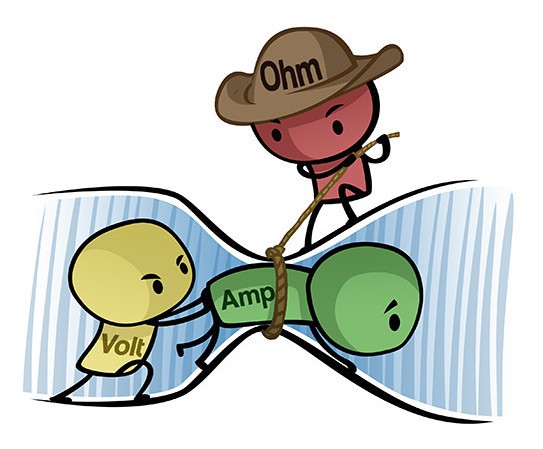 Look at the drawing above and see if it makes sense to you that: - If you increase the voltage (Volt) in a circuit while the resistance is the same, you get more current (Amp).
- If you increase the resistance (Ohm) in a circuit while the voltage stays the same, you get less current.
Ohm’s law is a way of describing the relationship between the voltage, resistance, and current using math: - V is the symbol for voltage.
- I is the symbol for current.
- R is the symbol for resistance.
I use it VERY often. It is THE formula in electronics. You can switch it around and get R = V/I or I = V/R. As long as you have two of the variables, you can calculate the last.  10 Simple Steps to Learn ElectronicsElectronics is easy when you know what to focus on and what to ignore. Learn what "the basics" really is and how to learn it fast. Ohm’s Law TriangleYou can use this triangle to remember Ohm’s law: 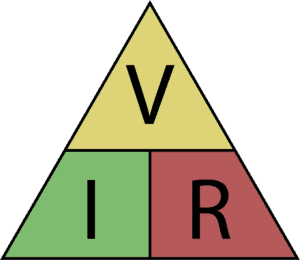 How to use it: Use your hand to cover the letter you want to find. If one of the remaining letters is above the other, it means dividing the top one by the bottom one. If they are next to each other, it means multiply one with the other. Example: VoltageLet’s find the formula for voltage: 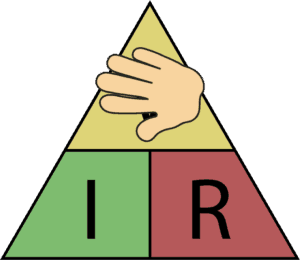 Place your hand over the V in the triangle, then look at the R and the I. I and R are next to each other, so you need to multiply. That means you get: Example: ResistanceLet’s find the formula for resistance: 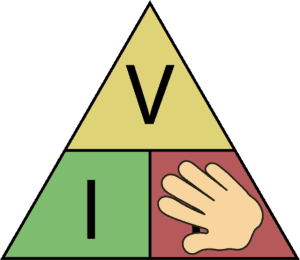 Place your hand over the R. Then you’ll see that the V is over the I. That means you have to divide V by I: Example: CurrentLet’s find the formula for current: 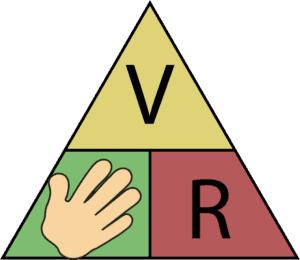 Place your hand over the I. Then you’ll see the V over the R, which means dividing V by R: Quick Tip: How to Remember Without the Triangle?A simple way of remembering things is to make a stupid association so that you remember it because it’s so stupid. So to help you remember Ohm’s law let me introduce the VRIIIIIIII! rule. Pretend that you’re driving a car really fast, then suddenly you hit the brakes really hard. What sound do you hear? “VRIIIIIIIIIIII!” And this way you can remember V=RI ;) Example: Using Ohm’s Law to Calculate Current in a CircuitThe best way to learn how to use Ohm’s law is by looking at some examples. Below is a very simple circuit with a battery and a resistor . The battery is a 12-volt battery, and the resistance of the resistor is 600 Ohms. How much current flows through the circuit? 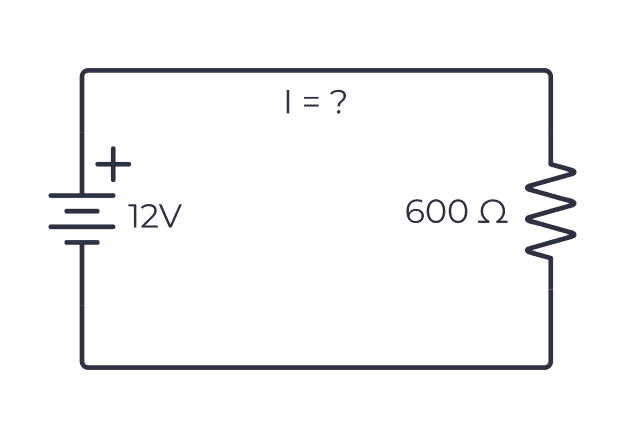 To find the amount of current, you can use the triangle above to the formula for current: I = V/R. Now you can calculate the current by using the voltage and the resistance. Just type it into your calculator to get the result: I = 12 V / 600 Ω I = 0.02 A = 20 mA So the current in the circuit is 20 mA. Example: Choosing a Resistor for an LED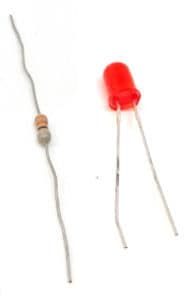 To safely power a Light-Emitting Diode (LED) , you should always have a resistor in series with it to limit the current that can flow. But what value should you choose? This is one of those practical situations where Ohm’s law becomes really useful. Below you can see a typical LED circuit with a resistor in series. The LED grabs 2V from the battery, so the rest of the voltage (9V minus 2V = 7V) drops across the resistor. Let’s imagine that this LED can only handle up to 10 mA. 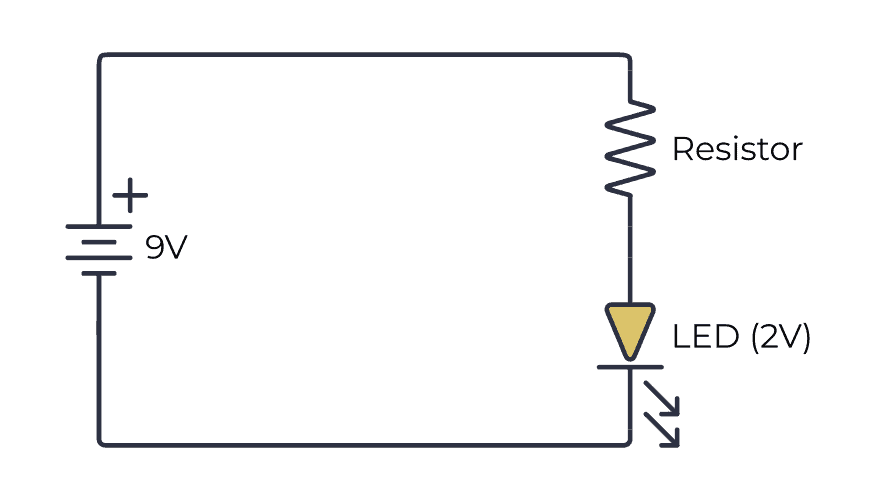 Since there is only one path for the current to take, the current through the resistor is the same as the current through the LED. So if you find the resistor value needed to get 10 mA through the resistor, then that’s what you’ll get through the LED as well. The battery voltage is 9V. The voltage across the LED is 2V. So the rest of the battery voltage has to drop across the resistor. That means the voltage across the resistor is 7V. And you want 10 mA (0.01A) through the resistor. Plug this into the formula for finding resistance (see above), and you’ll get the needed resistor value: R = V / I R = 7 V / 0.01 A R = 700 Ω This means you need a resistor of 700 Ω to set the current to 10 mA. Example: Figuring Out the Battery VoltageLet us try another example. Below we have a circuit with a resistor and a battery again. But this time we don’t know the voltage of the battery. Instead, we imagine that we have measured the current in the circuit and found it to be 3 mA (same as 0.003 A). 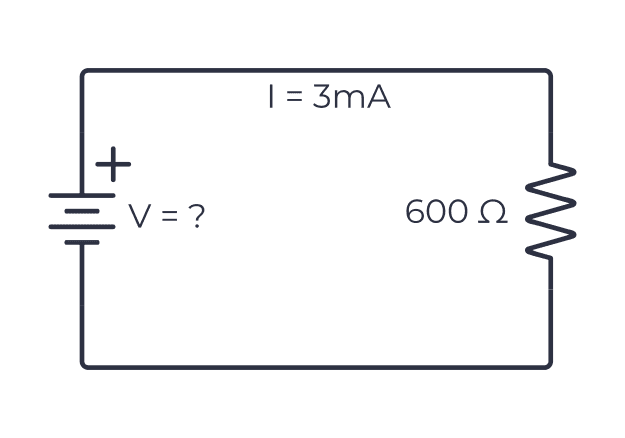 The resistance of the resistor is 600 Ω. What is the voltage of the battery? By remembering the “VRIIII!” rule, you get: V = R * I V = 600 Ω * 0.003A V = 1.8 V So the voltage of the battery must be 1.8 V. More Basic Electronics Tutorials- Understanding Basic Electronics
- Basic Electronic Components Used in Circuits
- Current, Voltage and Resistance
- What Is Electric Current?
- Series and Parallel Circuits
- Voltage Divider Tutorial For Beginners
- Kirchhoff’s Law of Voltage and Current
- Thevenin’s Theorem
- Alternating Current (AC) vs Direct Current (DC)
- What Is a Short Circuit?
- What is Negative Voltage?
- The RC Delay Element
- Tips: How to combine components?
- Tips: An expert in electronics does easier tasks
- Tips: This trick will help you understand circuits
- Tips: How a circuit simulator can help you understand any circuit
 Get Our Basic Electronic Components GuideLearn how the basic electronic components work so that circuit diagrams will start making sense to you. Your Physicist I will answer anything from the world of physics. Ohm’s Law Practice ProblemsIntroduction to ohm’s law. Ohm’s Law is one of the fundamental principles of electrical engineering. It is used to calculate electric current, voltage, and resistance in a circuit. The law states that the current passing through a conductor between two points is directly proportional to the voltage across the two points and inversely proportional to the resistance between them. In simpler terms, Ohm’s Law can be defined as the relationship between current, voltage, and resistance in an electrical circuit. Mastering Ohm’s Law FormulaThe formula for Ohm’s Law is I = V/R, where I is the current in amperes, V is the voltage in volts, and R is the resistance in ohms. This formula can be used to calculate any one of the three variables if we know the value of the other two. To solve Ohm’s Law problems, we need to be familiar with the formula and its units, and we also need to have a good understanding of the concepts behind the formula. Ohm’s Law Practice Problems ExampleLet’s consider an example to see how we can apply Ohm’s Law to a real-world problem. Suppose we have a circuit with a resistance of 100 ohms and a voltage of 10 volts. We can use Ohm’s Law to calculate the current in the circuit as follows: I = 0.1 amperes So, the current in the circuit is 0.1 amperes. Similarly, we can use Ohm’s Law to calculate the voltage or resistance in the circuit if we know the values of the other two variables. Tips for Solving Ohm’s Law ProblemsTo solve Ohm’s Law problems, we need to follow certain tips and tricks. Here are a few tips that can help: - Always pay attention to the units of measurement. Make sure that the units are consistent throughout the problem.
- Use the correct formula for the problem. Ohm’s Law has several variations, depending on the variables involved.
- Draw a diagram of the circuit if necessary. This can help you visualize the problem and identify the variables.
- Solve the problem step by step, and don’t skip any intermediate calculations.
- Check your answer to make sure that it makes sense. For example, if you get a negative value for current, it means that you have made a mistake somewhere.
By following these tips and practicing Ohm’s Law problems regularly, you can master this fundamental principle of electrical engineering. If you're seeing this message, it means we're having trouble loading external resources on our website. If you're behind a web filter, please make sure that the domains *.kastatic.org and *.kasandbox.org are unblocked. To log in and use all the features of Khan Academy, please enable JavaScript in your browser. Class 10 Physics (India)Course: class 10 physics (india) > unit 3. - Ohm's law
- Solved example: Ohms law
- Ohm's law and resistance
- Ohm's law graph (verifying Ohm's law)
- Solved example: (Ohm's law graph)
Ohm’s Law – Statement and Solved ExamplesIn this article, we will learn about Ohm’s law , its statement, formula, and solved examples based on it. In electric circuits, Ohm’s law is a fundamental tool for analyzing electric circuits. This law provides a relationship between the voltage , current, and resistance of an electric conductor. Let’s start our study with the definition or statement of Ohm’s law. Table of Contents  Ohm’s Law DefinitionOhm’s law is the most fundamental circuit law stated by the German Scientist George Simon Ohm . This law states that The voltage applied across a conductor or wire is directly proportional to the electric current flowing through it . This statement holds true only if the physical conditions like area, length, temperature, etc. of the conductor do not change. If the physical conditions of the conductor are not constant, then Ohm’s law cannot be applied to that conductor. For example, we cannot use Ohm’s law to analyze the internal circuit of an incandescent lamp. It is because the temperature and hence the resistance of the lamp filament under the OFF state and ON state is different. In practice, under normal operating conditions, the resistance of the lamp filament is around 10 times its resistance in the OFF state. Ohm’s Law FormulaFrom the statement of the Ohm’s law, we can write, Where, V is the voltage applied across the conductor and I is the resulting current flowing through the conductor. Where, R is a constant of proportionality, known as resistance of the conductor. Let us consider a conductor as shown in the following figure.  The voltage or potential difference applied across the conductor is V volts, the current flowing through the conductor is I amperes, and R ohms is the resistance of the conductor, then, we can write, Also, the current through the conductor is given by, $$I=\frac{V}{R}$$ The resistance of the conductor can be given by, $$R=\frac{V}{I}$$ If any two of the three parameters are known for a given conductor, then the third one can be calculated using any of the above Ohm’s law equations. Ohm’s Law TriangleThe Ohm’s law triangle is a graphical representation of the Ohm’s law equations. This triangle is shown in the following figure.  Let us now take some solved numerical examples to understand the application of Ohm’s law. Examples based on Ohm’s LawNumerical Example (1) – What is the value of resistance R of a copper wire if the voltage drop across the conductor is 240 V and the current through the wire is 2.5 A? Solution – From the problem, we have, $$V=240 V$$ $$I=2.5 A$$ Then, according to Ohm’s law, $$R=\frac{V}{I}=\frac{240}{2.5}$$ $$∴R=96 Ω$$ Thus, the resistance of the given copper wire is 96 ohms. Numerical Example (2) – If a conductor strip has a resistance of 25 ohms, and the voltage across it is 220 V. Find the current flowing through the strip. Solution – We are given the following, $$V=220 V$$ Applying Ohm’s law, we get the current as, $$I=\frac{V}{R}=\frac{220}{25}$$ $$∴I=8.8 A$$ Hence, the given conductor strip is carrying a current of 8.8 A. Numerical Example (3) – If a cable is carrying a current of 6 A and its resistance is 5 ohms. What will be the voltage drop across the cable? Solution – Given, According to Ohm’s law, the voltage drop across the cable will be, $$V=IR=6×5$$ Hence, the voltage drop across the cable is 30 volts. Practice Problems based on Ohm’s LawTry solving the following numerical problems based on Ohm’s law formula. Q. 1 – An aluminum coil has a resistance of 10 Ω and a voltage drop across it is 260 V. Find the current flowing through the coil. Q. 2 – A copper wire has a resistance of 50 Ω. Find the voltage drop across the wire if it carries a current of 4.5 A. Q. 3 – When an electric heater is connected to an electric supply of 220 volts, it draws a current of 16 A. Calculate the resistance of the filament of the heater, neglecting the resistance of connecting wires and cables. Leave a Comment Cancel replySave my name, email, and website in this browser for the next time I comment. 2024 © Electrical Vani | All rights reserved About Us | Privacy Policy | Disclaimer | Terms and Conditions | DMCA | Contact Us - Physics Concept Questions And Answers
- Ohms Questions
Ohm’s Law QuestionsOne of the basic laws of Physics is Ohm’s law. It gives the relationship between electric current and potential difference. Ohm’s law was experimentally verified by a German physicist Georg Simon Ohm. Ohm’s law states that the voltage across a conductor is directly proportional to the current flowing through it, provided all physical conditions and temperature remain constant. In the equation, the constant of proportionality: R, is Resistance and has units of ohms, with the symbol Ω. We can rewrite the formula in order to calculate the current and resistance, respectively, as follows: If the temperature and the other physical factors remain constant, Ohm’s law holds true. This continuous movement of electric charge through the conductors of a circuit is called a current. The force motivating charge carriers to flow in a circuit is called voltage. This opposition to the motion of charges is more appropriately called resistance. The standard units of measurement for electrical current, voltage, and resistance are Ampere, volt, and Ohm. Power is given by the formula using voltage and current: When the values for voltage and resistance are given: \(\begin{array}{l}P=V^{2}\div R\end{array} \) When the values for current and resistance are given: \(\begin{array}{l}P=I^{2}R\end{array} \) Applications of Ohm’s law: - Ohm’s law is used to find an electric circuit’s voltage, resistance, or current.
- Ohm’s law is used to maintain the desired voltage drop across the electronic components.
- Ohm’s law is used in DC ammeter, and other DC shunts to divert the current.
The limitations of Ohm’s law are: - Ohm’s law is not applicable for unilateral electrical elements like diodes and transistors as they allow the current to flow through in one direction only.
- For non-linear electrical elements with parameters like capacitance, resistance, etc., the voltage and current won’t be constant with respect to time, making it difficult to use Ohm’s law.
Important Ohm’s Law Questions with Answers 1. What is the unit of measurement of current? Answer: d) Ampere Explanation: The unit of measurement of current is Ampere. 2. State true or false: Ohm’s law is universal. Answer: FALSE. Explanation: Ohm’s law is not universal since it is not applicable for non-ohmic conductors like semiconductors. 3. Fill in the blanks: current-voltage relationship is given by the formula _____ Answer: V=IR 4. Ohm’s law is named after which scientist? It is named after the scientist Georg Simon Ohm. 5. _____ volt of pressure is needed to push one amp of current through one ohm of resistance. Answer: b) One 6. Current density is represented by the alphabet. Answer: d) J Explanation: Current density is represented by the symbol ‘J’. 7. The SI unit of electrical resistance is the _____ Answer: c) Ohm 8. Fill in the blanks: The electrical conductance is measured in _____ Answer: Siemens 9. State true or false: The lightbulb filament violates Ohm’s Law. Answer: TRUE Explanation: Temperature rises as the current increases in the filament; hence it violates Ohm’s law. 10. The unit of power is Answer: c) Watts Practice Questions - State and explain Ohm’s law.
- Give the formula to calculate the power using voltage and current.
- List the applications of Ohm’s law.
- Can we apply Ohm’s law to diodes and transistors?
- State true or false: Ohm’s law holds good only if the provided temperature and the other physical factors remain constant.
Recommended VideosLeave a Comment Cancel replyYour Mobile number and Email id will not be published. Required fields are marked * Request OTP on Voice Call Post My Comment  Register with BYJU'S & Download Free PDFsRegister with byju's & watch live videos. HIGH SCHOOL- ACT Tutoring
- SAT Tutoring
- PSAT Tutoring
- ASPIRE Tutoring
- SHSAT Tutoring
- STAAR Tutoring
GRADUATE SCHOOL- MCAT Tutoring
- GRE Tutoring
- LSAT Tutoring
- GMAT Tutoring
- AIMS Tutoring
- HSPT Tutoring
- ISAT Tutoring
- SSAT Tutoring
Search 50+ TestsLoading Page math tutoring- Elementary Math
- Pre-Calculus
- Trigonometry
science tutoringForeign languages. elementary tutoringSearch 350+ Subjects- Video Overview
- Tutor Selection Process
- Online Tutoring
- Mobile Tutoring
- Instant Tutoring
- How We Operate
- Our Guarantee
- Impact of Tutoring
- Reviews & Testimonials
- About Varsity Tutors
AP Physics 1 : Ohm's LawStudy concepts, example questions & explanations for ap physics 1, all ap physics 1 resources, example questions, example question #1 : ohm's law. Consider the circuit:  First we need to calculate the equivalent resistance of the circuit using the following expression for condensing parallel resistors:  Now we can use Ohm's law to calculate the current flowing through the circuit:  Example Question #2 : CircuitsA light bulb requires 60 W to function properly. If it is connected to a powersupply of 120 A and functions properly, then what is the resitance of the light bulb?  First, identify the given information:  Two equations are required for this problem:  At this point, we can substitute in the known values and determine the voltage:  Ohm's law can then be rearranged to solve for the resistence of the light bulb:  The known voltage value then can be substituted into Ohm's law to determine the resistance of the light bulb:  Example Question #101 : Electricity And Waves Use Ohm's law.  Plug in known values and solve for resistance.  Example Question #1 : Circuits Use Ohm's Law.  UseOhm's law.  Plug in known values and solve.  Begin by finding the total resistance in the circuit.  Now note that the voltage identified in the problem is the same as the voltage drop across the second resistor:  Begin by finding the total resistance in the circuit.  Example Question #9 : Circuits In the circuit above, what is the current?  Use Ohm's law to find the current.  Ohm's law states that the potential drop across a resistor is equal to the product of the current flowing through the resistor and the resistance of the resistor:  We were given the current, I, and the resistance, R, so we simply multiply the two together to get our final answer.  Report an issue with this questionIf you've found an issue with this question, please let us know. With the help of the community we can continue to improve our educational resources. DMCA ComplaintIf you believe that content available by means of the Website (as defined in our Terms of Service) infringes one or more of your copyrights, please notify us by providing a written notice (“Infringement Notice”) containing the information described below to the designated agent listed below. If Varsity Tutors takes action in response to an Infringement Notice, it will make a good faith attempt to contact the party that made such content available by means of the most recent email address, if any, provided by such party to Varsity Tutors. Your Infringement Notice may be forwarded to the party that made the content available or to third parties such as ChillingEffects.org. Please be advised that you will be liable for damages (including costs and attorneys’ fees) if you materially misrepresent that a product or activity is infringing your copyrights. Thus, if you are not sure content located on or linked-to by the Website infringes your copyright, you should consider first contacting an attorney. Please follow these steps to file a notice: You must include the following: A physical or electronic signature of the copyright owner or a person authorized to act on their behalf; An identification of the copyright claimed to have been infringed; A description of the nature and exact location of the content that you claim to infringe your copyright, in \ sufficient detail to permit Varsity Tutors to find and positively identify that content; for example we require a link to the specific question (not just the name of the question) that contains the content and a description of which specific portion of the question – an image, a link, the text, etc – your complaint refers to; Your name, address, telephone number and email address; and A statement by you: (a) that you believe in good faith that the use of the content that you claim to infringe your copyright is not authorized by law, or by the copyright owner or such owner’s agent; (b) that all of the information contained in your Infringement Notice is accurate, and (c) under penalty of perjury, that you are either the copyright owner or a person authorized to act on their behalf. Send your complaint to our designated agent at: Charles Cohn Varsity Tutors LLC 101 S. Hanley Rd, Suite 300 St. Louis, MO 63105 Or fill out the form below: Contact InformationComplaint details.  | Email address: | | | Your name: | | | Feedback: | | Ohm’s Law-Satatement, Formula, Solved ExamplesWhat is ohm’s law . Ohm’s law states the relationship between the potential difference and current in the circuit. The current in the circuit depends on the voltage and its circuit resistance. The Ohm’s law establishes the relationship between current, voltage, and resistance. Georg Simon Ohm experimented to find the relationship between the electric current and voltage. Ohm’s Law Statement & DefinitionOhm’s law states that the current flowing in the circuit is; Why temperature is kept constant in Ohm’s law?Ohm’s law explanation. When we increase the voltage across the conductor, the current also increases in the same proportion of the potential difference across the conductor. The conductor has definite resistance. We denote the resistance by the symbol ‘R’. Unit of resistance is Ohm. Its symbol is Ω. Relationship Between Voltage, Current and ResistanceThe results of the experiment are as per the table given below. Ohm’s Law WorksheetFrom above results, it is clear that the current flowing in the resistance is directly proportional to the voltage across the resistance. If we draw the graph between I and V, the graph is a straight line. Ohm’s Law GraphOhm’s law equation. Where 1/R is the constant. R is the resistance of the circuit. We can write this equation in other forms as well. Ohm’s Law FormulaWe can write the equation V= IR in the following forms. We can use the same formula by arranging it to calculate current and resistance respectively. Ohm’s Law Magic TriangleWe can make use of the below-given magic triangle to remember the different equations of this law to solve for different variables(V, I & R). Ohm’s Law ApplicationsThe main applications of this law are as follows. Limitations of Ohm’s LawOhm’s law solved problems. Example 1: If the resistance of an electric kettle is 60 Ω and a current of 4 A flows through the resistance. Find the voltage between two points. Here, I = 4 A, R =60 Ω Substituting the values in the equation, we get V = 4 X 60 V = 240 Volts R = 100 Ω V= 100 Volts I = 100/100 = 1 Amps. Example 3: Find the current I through a resistor of resistance R = 3 Ω if the voltage across the resistor is 6 V. R = 3 Ω V= 6 Volts I = V/R I = 6/3 = 2 Amps. Read Next : 1 thought on “Ohm’s Law-Satatement, Formula, Solved Examples”Leave a comment cancel reply. Ohm's law - practice problemsNumber of problems found: 102.  - all math problems 19044
- themes, topics 3081
- Ohm's law 102
- electrical engineering 86
- fundamentals of Physics 45
- unit conversion 11
- expression of a variable from the formula 9
- direct proportionality 7
- area of a shape 6
 - New math problems
- Popular math problems
- Harder math problems
- The easiest word problems
 | 

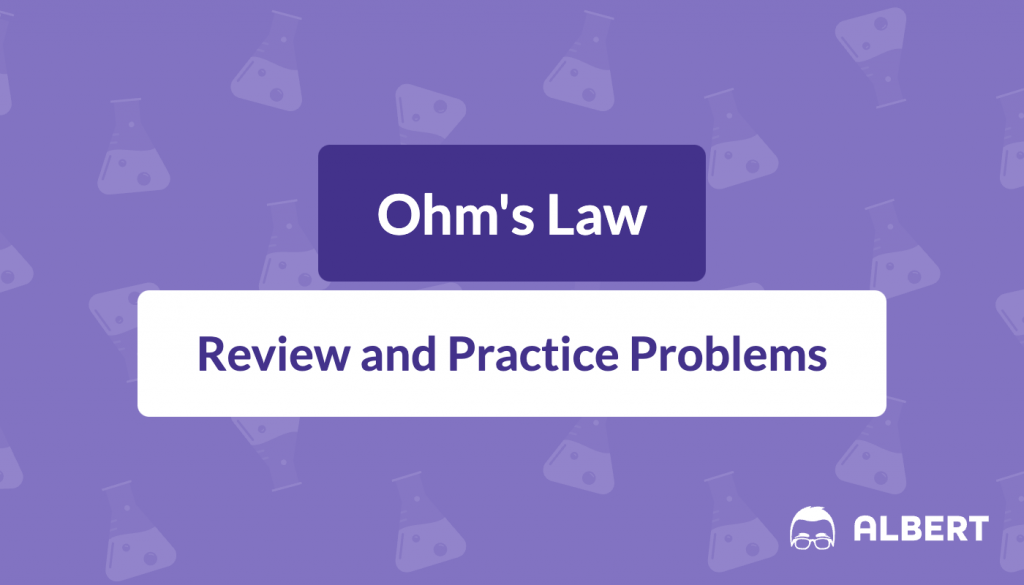

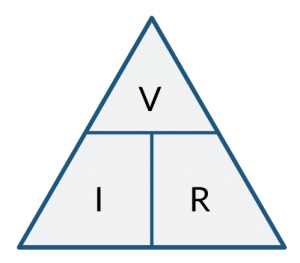
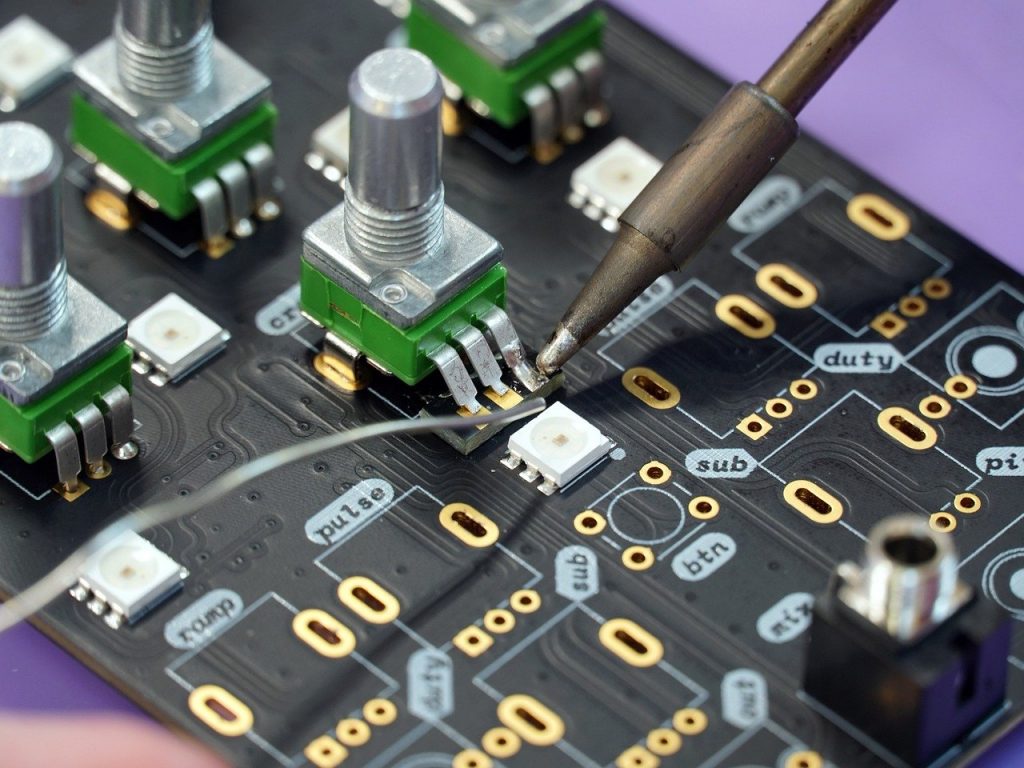



























































COMMENTS
Ohm's Law Formula. V = IR V = I R. In the formula for Ohm's Law, V V represents voltage measured in volts (V), I I is the current measured in amperes (A), and R R is the resistance measured in ohms (Ω). This formula is the cornerstone for analyzing and understanding electrical circuits, requiring two variables to solve.
Example 1 Find the current I through a resistor of resistance R = 2 Ω if the voltage across the resistor is 6 V. Solution to Example 1 Substitute R by 2 and V by 6 in Ohm's law V = R I. 6 = 2 I Solve for I I = 6 / 2 = 3 A. Example 2 In the circuit below resistors R1 and R2 are in series and have resistances of 5 Ω and 10 Ω, respectively.
Ohm's Law Practice Problems With Solutions for High School. Excel in solving any Ohm's law problems with this comprehensive guide. It's your ultimate toolkit for tackling homework and acing the AP Physics exam. If you are a teacher looking for a resource to assess your students, download this Ohm's law worksheet. Ohm's Law Practice Problems:
Ohm's Law Solved Problems. Example 1: If the resistance of an electric iron is 50 Ω and a current of 3.2 A flows through the resistance. Find the voltage between two points. Solution: If we are asked to calculate the value of voltage with the value of current and resistance, then cover V in the triangle.
Problem 1. Node A: 1000V to Node B: 0V, across a 100 ohm resistor. Solution: In this first practice ohm's law problem, we establish the voltage drop across the resistor and setup the equation. Node A is 1000 volts and Node B is 0 volts, so we can setup the equation as 1000V - 0V, and then divide it by the resistance, which is 100 ohms. So we get:
It is a fundamental principle in physics that relates voltage, current, and resistance in a circuit. Ohm's Law Formula is: V = I x R. Where: I = current, and R = resistance. The SI unit of ohms law is in ohms (Ω) In simpler terms, Ohm's Law allows us to determine the value of one variable (voltage, current, or resistance) if we know the ...
Problem: 5. A circuit is made of 0.4 Ω wire, a 150Ω bulb and a 120Ω rheostat connected in series. Determine the total resistance of the circuit. Given data: Resistance of the wire = 0.4Ω. Resistance of bulb = 150Ω. Resistance of rheostat = 120Ω. To find:
Ohm's Law Practice Problems Using Ohm's Law, solve the following problems. Be sure to show all work. Formula: V (voltage)= I (current) X R (resistance) 1. What is the voltage if a resistance of 25 Ωproduces a current of 250 amperes? 2. What is the current produced by a voltage of 240 V through a resistance of 0.2 Ω? 3.
Problem. Gina connects a power supply providing voltage, V = 5.0 V , across a resistor of unknown resistance. With an ammeter, she measures a current, I = 0.20 A , across the resistor. What is the value of the resistance, R ? R = Ω. Report a problem. Do 3 problems. Learn for free about math, art, computer programming, economics, physics ...
Ohm's law is a way of describing the relationship between the voltage, resistance, and current using math: V = R * I. V is the symbol for voltage. I is the symbol for current. R is the symbol for resistance. I use it VERY often. It is THE formula in electronics. You can switch it around and get R = V/I or I = V/R.
Ohm's Law Practice Problems Example. Let's consider an example to see how we can apply Ohm's Law to a real-world problem. Suppose we have a circuit with a resistance of 100 ohms and a voltage of 10 volts. ... Tips for Solving Ohm's Law Problems. To solve Ohm's Law problems, we need to follow certain tips and tricks. Here are a few ...
Calculating resistance, voltage, and current using Ohm's law. A student builds a simple circuit with a single resistor with resistance 2 R and measures an electric potential difference Δ V across the resistor. Then, the student replaces the resistor with a new one of resistance R 2 and keeps the electric potential difference the same.
In this way, the electric potential at any point in the electric field is the electric potential energy of a unit positive charge at that point. If W is the work done in moving a unit positive charge q from infinity to a certain point in the field, the electric potential V at this point is given by: V = W/q.
For example, we cannot use Ohm's law to analyze the internal circuit of an incandescent lamp. It is because the temperature and hence the resistance of the lamp filament under the OFF state and ON state is different. ... Practice Problems based on Ohm's Law. Try solving the following numerical problems based on Ohm's law formula. Q. 1 ...
0:00 Opening & What's Covered0:23 Problem Statement1:04 What Are We Solving For?3:12 Applying Kirchhoff's Current Law3:55 Applying Ohm's Law5:30 Solving for ...
Contents1 Ohm's Law Explanation and Verification1.1 Resistance of a Conductor1.2 Graph Between V and I1.3 Experiment to Verify Ohm's Law1.4 Good Conductors, Resistors and Insulators1.5 Electrical Resistance Understanding Physics Topics is essential for solving complex problems in many fields, including engineering and medicine. Ohm's Law Explanation and Verification Ohm's law gives a ...
Ohm's law, example problems. Goes over several worked examples when solving for voltage, current and resistance using ohm's law.Ohm's law, V = I x R, states ...
Ohm's Law Practice Problems #1. By Patrick Hoppe. Learners review Ohm's Law and then work 12 problems. In each of the problems, students are given two of the three variables (voltage, resistance, or current) and are asked to solve for the third. Related.
Download Ohm's law practice worksheet (With answers) Or continue learning below: Solved: Ohm's Law is named after George Simon Ohm a German physicist. Ohm performed repeated experiments on a resistor, applied different voltages, measured current and found relationship between these quantities. He finally published the law in 1827 and ...
State true or false: Ohm's law is universal. TRUE. FALSE. Answer: FALSE. Explanation: Ohm's law is not universal since it is not applicable for non-ohmic conductors like semiconductors. 3. Fill in the blanks: current-voltage relationship is given by the formula _____. Answer: V=IR. 4.
Two equations are required for this problem: 1.) Ohm's law, 2.) Electrical power . Using the equation for electrical power, we can rearrange to solve for : At this point, we can substitute in the known values and determine the voltage: Ohm's law can then be rearranged to solve for the resistence of the light bulb:
Ohm's Law Solved Problems. Example 1: If the resistance of an electric kettle is 60 Ω and a current of 4 A flows through the resistance. Find the voltage between two points. Solution: Here, I = 4 A, R =60 Ω. voltage ( V) = IR. Substituting the values in the equation, we get. V = 4 X 60.
Ohm's law - practice problems. Ohm's law states that the current through a conductor (or resistor) between two points is directly proportional to the voltage across the two points. Introducing the constant of proportionality, the resistance, it arrives at the usual mathematical equation I = U/R or I=V/R. Direction: Solve each problem carefully ...